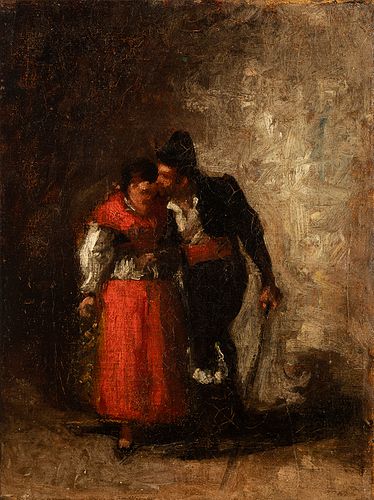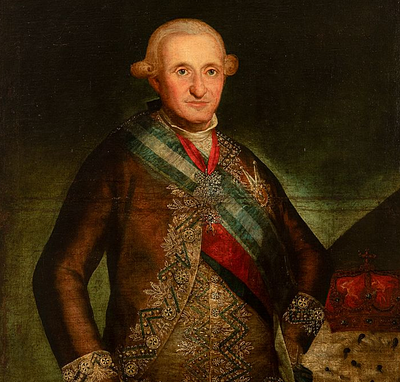Circle of EUGENIO LUCAS VELAZQUEZ (Madrid, 1817 - 1870); circa 1840-1850. Untitled. Oil on canvas. Antique relined
Lot 58
About Seller
Setdart Auction House
Carrer Aragó 346
Barcelona
Spain
Setdart Subastas was born in 2004 and is currently the first online art auction in Spain with solidity, prestige and reliability guaranteed by our more than 60,000 users. Setdart has a young, dynamic and enterprising team ready to successfully manage the purchase and sale of art works through custom...Read more
Estimate:
EUR€900 - EUR€1,200
$927.84 - $1,237.11
Absentee vs Live bid
Two ways to bid:
- Leave a max absentee bid and the platform will bid on your behalf up to your maximum bid during the live auction.
- Bid live during the auction and your bids will be submitted real-time to the auctioneer.
Bid Increments
| Price | Bid Increment |
|---|---|
| EUR€0 | EUR€10 |
| EUR€200 | EUR€25 |
| EUR€500 | EUR€50 |
| EUR€1,000 | EUR€100 |
| EUR€3,000 | EUR€200 |
| EUR€5,000 | EUR€500 |
| EUR€10,000 | EUR€1,000 |
| EUR€20,000 | EUR€2,000 |
| EUR€50,000 | EUR€5,000 |
About Auction
By Setdart Auction House
Sep 22, 2021
Set Reminder
2021-09-22 09:30:00
2021-09-22 09:30:00
America/New_York
Bidsquare
Bidsquare : 22nd September - ARAS JÁUREGUI Private Collection - Old Masters, 19th & 20th Century
https://www.bidsquare.com/auctions/setdart-auction-house/22nd-september---aras-j-uregui-private-collection---old-masters-19th-20th-century-7427
ARAS JÁUREGUI Private Collection - Old Masters, 19th & 20th Century Setdart Auction House sofia@setdart.com
ARAS JÁUREGUI Private Collection - Old Masters, 19th & 20th Century Setdart Auction House sofia@setdart.com
- Lot Description
Circle of EUGENIO LUCAS VELAZQUEZ (Madrid, 1817 - 1870); circa 1840-1850. Untitled. Oil on canvas. Antique relined Size: 23,5 x 17,5 cm. This type of themes in which young women were represented dressed as majas, being harassed by men or together with older women as a celestina, became popular during the period. Such images were used as a criticism of the society of the time. Mentioned since the 19th century as Eugenio Lucas Padilla, or Eugenio Lucas the Elder, he was the Spanish Romantic artist who best understood Goya's art. Trained in Neoclassicism at the San Fernando Academy, he soon turned his training around and devoted himself to studying Velázquez and, above all, Goya, whose works he admired and copied in the Prado Museum. In Goya's painting, Lucas Velázquez found the starting point for developing his own imaginative personal painting of fantastic visions and unleashed passions, in the purest Romantic style. He also took his subject matter from Goya and painted scenes of the Inquisition, witches' Sabbaths, pilgrimages and bullfights. In 1850 he also painted the ceiling of the Royal Theatre in Madrid, which no longer exists, and later he was appointed honorary chamber painter and knight of the order of Charles III by Queen Isabella II. As a true Romantic, he made several trips, including stays in Italy, Morocco and Paris. His works are characterised by the use of a spirited brushstroke and an unhurried execution, without any concern for drawing, with a dense, impastoed material of great chromatic richness and the presence of strong chiaroscuro. He achieved great success as a genre painter and as a painter of fantastic and sinister scenes, although he was also an excellent landscape and portrait painter. His work is well represented in the Prado Museum, and also in other centres such as the Bilbao Fine Arts Museum, the National Art Museum of Catalonia, the Lázaro Galdiano Museum, the British Museum, the Metropolitan Museum in New York and the Goya Museum in Castres (France).
- Shipping Info
-
In-house shipping available. Please inquire at admin@setdart.com.
-
- Buyer's Premium



 EUR
EUR CAD
CAD AUD
AUD GBP
GBP MXN
MXN HKD
HKD CNY
CNY MYR
MYR SEK
SEK SGD
SGD CHF
CHF THB
THB















